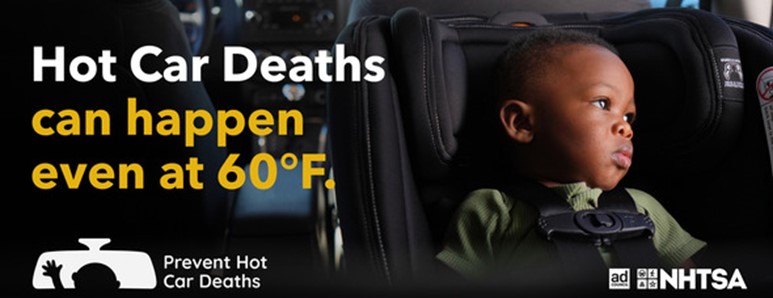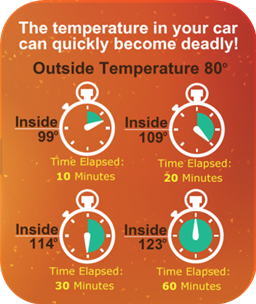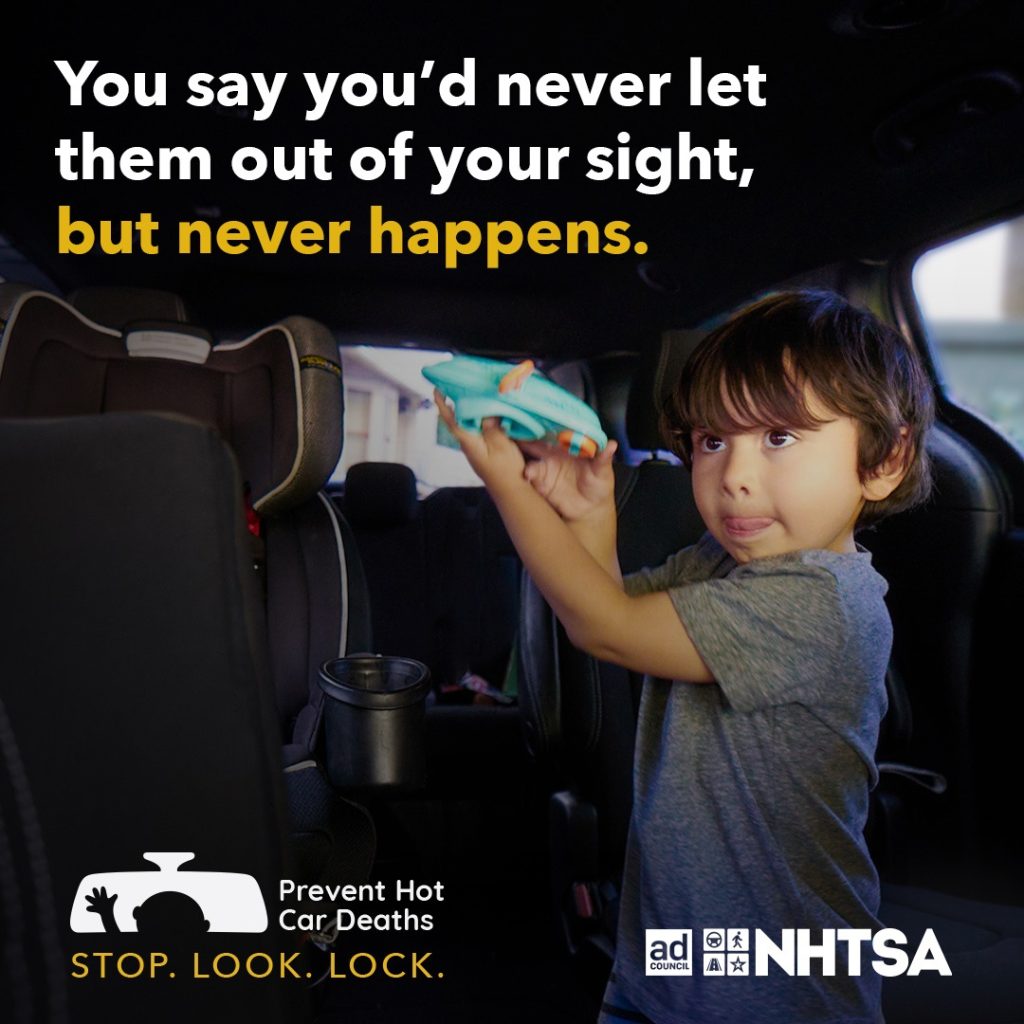
Vehicular heatstroke is the leading cause of non-crash, vehicle-related death for children 14 and younger in the United States. On average, one child dies from heatstroke every 10 days in the United States from being left in a car or crawling into an unlocked vehicle. Tragically, every single one of these deaths could have been prevented.

Hot cars are deadly: Internal vehicle temperatures can rise quickly and become up to 50 degrees warmer than outside air temperatures. Because a child’s body temperature increases 3 to 5 times faster than an adult’s, even a cool day outside may still pose a threat to a child.
- Heatstroke begins when the core body temperature reaches approximately 104° F.
- A core temperature of approximately 107° F is lethal.
- Children are more sensitive to heat than adults.
- Children are at a higher risk because their body temperature rises 3 to 5 times faster than an adult’s.
- The children most at-risk for heatstroke are those younger than 1 year.
- In 10 minutes, a car can heat up by as much as 20° F.
- Rolling down a window does little to keep a vehicle cool.

Once You Park, STOP.LOOK.LOCK


- Three Tips Could Safe a Child’s Life:
- NEVER Leave a child in a vehicle unattended.
- Make it a habit to look in the back seat EVERY time you exit the car.
- ALWAYS lock the car and put the keys out of reach.
- Teach children that a vehicle is not a play area.

- Every Death is Preventable
- As temperatures start to rise across the country, it is essential for parents and caregivers everywhere to remember: Stop. Look. Lock.
- The three main scenarios in which heatstroke occurs are:
- Children are forgotten in vehicles by parents or caregivers.
- The primary way a child dies from heatstroke is from a parent or caregiver “forgetting” their child in a vehicle. There are many factors at play, but a common one is a change in routine. Every family experiences a change in routine at some point, so every parent or caregiver is susceptible to this mistake.
- Children gain access to unlocked vehicles and become trapped inside.
- Toddlers and young children are also at risk, as they can climb into a vehicle without supervision. Children may be playing or hiding, but if they enter a vehicle without the knowledge of an adult, they may be unable to get out of the car, especially if child locks are activated. It is essential to teach children that cars are not a place to play. Parents and caregivers should get into the habit of storing keys and fobs out of a child’s reach.
- Children are knowingly left in vehicles by parents or caregivers.
- Sometimes, children are left intentionally by parents or caregivers who do not understand the dangers of a hot vehicle and may have a quick errand to run, or who may not understand how quickly a vehicle can heat up to deadly temperatures. It cannot be overstated: Never leave a child in a vehicle alone, not even for a minute.
- Children are forgotten in vehicles by parents or caregivers.
- It is critical that all parents, caregivers, and drivers understand that children should never be left alone in a vehicle, not even for a minute.
- The warning signs of heatstroke vary, but may include:
- Red, hot, and moist or dry skin
- Absent sweating, even though the child is warm
- Strong rapid pulse or a slow weak pulse
- Throbbing headache
- Dizziness
- Nausea
- Confusion
- Grouchiness or strange behavior
- If you see a child in distress in a vehicle, act. Call 911 immediately and get help.
- If you see a child alone in a locked car, act immediately and call 911. A child in distress due to heat should be removed from the vehicle as quickly as possible and rapidly cooled.
Resources:
For more information on vehicle heatstroke, what to do if you see a child trapped in a vehicle, and warning signs of heatstroke, visit www.nhtsa.gov/campaign/heatstroke.
For current data, visit noheatstroke.org.
Flyer: Leaving Children Alone in Hot Cars – Know the Risks and Consequences
